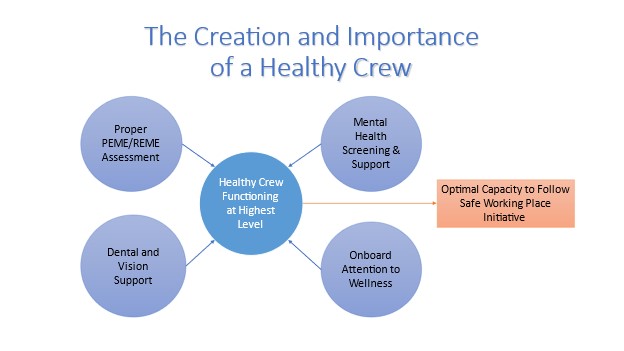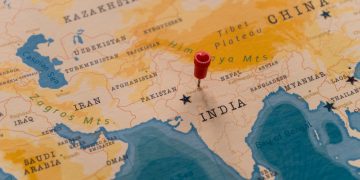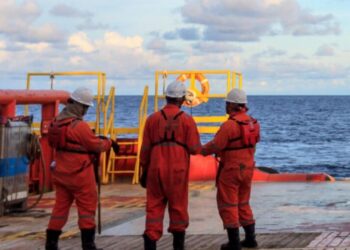The wellness of crew members in the maritime industry is of paramount importance not only for the individuals themselves but also for the overall safety and efficiency of the industry, highlights Arthur Diskin, Global Chief Strategy Officer, AP Companies.
Crew members face unique challenges such as long periods away from home, isolation, stressors related to the job, and the potential for mental health issues. Therefore, implementing wellness programs for crew members is crucial to ensure their physical, mental, and emotional well-being while at sea.
Crew wellness starts with the pre-employment medical exam (PEME) and is maintained by quality re-employment medical exams (REME). Wellness starts here:
- Qualified credentialed facilities that adhere to high standards
- Age and gender specific processes
- Acknowledging disease prevalence in specific populations
- Mental health screening culturally sensitive and specific and specific to mariner stressors
- Dental and vision
- Maintenance medications all year round
- Cognitive evaluation of older officers
A throughly conducted PEME, which includes all the abovementioned components and undergoes detailed scrutiny by medical professionals to validate its authenticity, forms the cornerstone of onboard crew safety and wellbeing. Investing in a comprehensive PEME not only leads to savings in medical costs but also ensures operational continuity and mitigates a multitude of potential risks. AP Companies’ enhanced PEME program is highly regarded by ship management and cruise companies for its role in confirming the fitness of onboard staff, thereby minimizing the presence of chronic health conditions that could impede their duties and jeopardize the safety of fellow seafarers.

There are many considerations to maintaining the wellness of crew:
- Sleep hygiene
- Exercise
- Hydration
- Diet
- Availability of medications
- Communication and social interaction
- Cultural and gender awareness
Mental health issues in mariners are a topic in and of itself. However, the stress of shipboard life must be recognized in any wellness program, including:
- Isolation
- Personality and interpersonal relationship issues from prolonged contracts
- Threats of violence from other crew – bullying
- Sleep disturbances and sleep disruptive schedules
- Performance of same job for prolonged periods – especially higher risk positions
- Boredom
- Low job satisfaction
- Lack of proper tools
- Lack of cultural and religious sensitivities
- Communications
Crew members may have undiagnosed or undisclosed mental health issues that can be exacerbated by the onboard environment. Hence the importance of mental health screening.
The somatization of psychological issues manifesting as physical complaints that must be evaluated medically, often at great cost to the company and personal cost to the crew members, is an ongoing problem necessitating excellent case management of crew on board, in port and upon repatriation.
Providing access to mental health resources, counseling services, and education on stress management techniques can help address the mental health challenges that crew members may face while at sea. Creating a supportive and open environment where crew members feel comfortable discussing their mental health concerns is also crucial.
AP Companies’ Telemedical services provide crew members and officers with access to psychologists and psychiatrists, ensuring constant support in their native language. This service not only benefits the crew by providing essential assistance but also empowers captains to identify and manage mental health issues among the crew effectively.
Wellness programs for crew should prioritize regular health assessments and screenings. This can help identify any potential health issues early on and allow for appropriate intervention and treatment. Additionally, promoting healthy lifestyle habits such as regular exercise, proper nutrition, and sufficient sleep can greatly benefit crew members’ overall health and well-being.
So, what can we do to enhance onboard health care to maintain crew wellness?
- Early recognition and management of acute and chronic medical issues.
- Encourage early reporting by crew of exacerbation of chronic illnesses.
- Rapid engagement of telemedicine for onboard consultations.
- Increased onboard telemedical devices.
- Online coaching – smoking cessation, obesity, diabetes, resiliency.
- Increased onboard treatment options such as oxygen concentrators.
- Port ahead program – what are the options in the event of a need for medical evacuation, diversion, or port health care for medical or traumatic conditions in the upcoming itinerary.
Promoting social interaction and connectivity among crew members is essential for their emotional well-being. Encouraging team-building activities, communication channels, and opportunities for crew members to connect with their families and loved ones back home can help combat feelings of isolation and loneliness often experienced at sea. Additionally, offering recreational activities, hobbies, and entertainment options on board can help alleviate boredom and improve overall morale.
Incorporating wellness training and education into crew members’ regular training programs can also be beneficial. Providing information on topics such as stress management, mental health awareness, healthy coping mechanisms, and self-care can empower crew members to take care of their well-being while at sea.
All maritime companies need to develop and maintain a CULTURE OF WELLNESS
How can this be accomplished? First, there must be an Organizational Champion, an executive level individual who believes that crew wellness is a key component of operations and that there is a return on investment to a well and safe crew. Next, there must be initiatives to address and identify indicators and the root causes of good and bad health amongst the crew. How many smokers, diabetics, obese crew are there and what is the relationship to medical utilization? Are a majority of medical utilizers from one location indicating an issue with PEME providers. Is there a relationship between contract length and medical utilization or mental health issues
By gathering relevant statistics and conducting thorough analysis, companies can utilize this information to draw meaningful conclusions and develop strategies to enhance crew wellness and safety.
The company should be open to crew/employee Initiated innovations for “quick wins” communicated across the fleet/company with real-time recognition of all ideas and programs related to wellness and safety. A well crew – mentally and physically – is a safe crew. Lastly, the Company should decide “What Does Success Look Like for You”. What are the goals of wellness and safety programs for your organization.
The choices we make are impacted by the choices we have
In conclusion, by prioritizing crew wellness and implementing comprehensive wellness programs, the industry can promote the health, safety, and overall well-being of its crew members, ultimately leading to a more productive and efficient workforce. Investing in the wellness of crew members not only benefits the individuals themselves but also contributes to the success and sustainability of the company and the industry.
The views presented are only those of the author and do not necessarily reflect those of SAFETY4SEA and are for information sharing and discussion purposes only.


































































